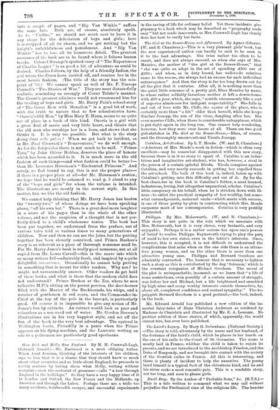TWO CHILDREN'S BOOKS.* The Parade exhibits a combination of all
the talents for the entertainment of the children. About a score of people clever with pen and pencil have been called in to help, and if the young readers find anything lacking it will certainly not be variety. Our experience of ventures so conducted is not altogether favourable. Some of the contributions are pretty sure to be " remnants," which are not of much ac- count except to fill a vacant space. " Undine " is condensed
• (1.) The Parade : an Illustrated Gift-book for Boys and Girls, 1897. Edited by Gleoson White. London: Henry and Co. 1897.—(2.) Prince Boohoo and Little Smuts. By Harry Jones. Drawings by Gordon Browne. Lyndon: Gardner, Darton, and Co.
into a couple of pages, and "Rip Van Winkle" suffers the same fate. Both are, of course, absolutely spoilt. As to " LTndine," we should not much care to have it in any shape for the delectation of boys and girls ; here it is stripped of all its charm, and we get nothing but the knight's unfaithfulness and punishment. And " Rip Van Winkle" has to lose all its humorous detail. The greatest successes of the book are to be found where it follows beaten tracks. Colonel Strange's spirited story of " The Experiences of Charles Legget " is as good a bit of adventure as could be desired. Charles follows, by the help of a friendly Indian, the girl whom the Crees have carried off, and rescues her in the most heroic fashion. (The title of the story has the mis- print of '95.) We cannot speak as well of Mr. F. Norreys Connell's " Two Stories of War." They are most distastefully realistic, reminding us strongly of Count TolstoI's manner. The Count's greatest admirers would not recommend him for the reading of boys and girls. Mr. Barry Pain's school-story of " The Great Row with Menallon " is a good bit of work, with the truth to nature that so few school-stories have. '. Onoria's Old Man," by Miss Mary E. Mann, seems to us quite out of place in a book of this kind. Onoria is a girl with a great deal of music and very little heart, and thinks that the old man who worships her is a bore, and shows that she thinks it. It is only too possible. But what is the story doing dans cette gaUTe ? When we get back to incident, as in Mr. Paul Creswick's " Bonaventure," we do well enough. As for the fairy-tales there is not much to be said. " Prince Toto," by John Oliver Hobbes, deserves the place of honour which has been accorded to it. It is much more in the old fashion of such things—and what fashion could be better ?— than Mr. Laurence Housman's " Enchanted Princess." And surely, we feel bound to say, this is not the proper place— if there is a proper place at all—for Mr. Housman's erotica ; we hope that he would be ashamed to read p. 3 aloud to any of the " boys and girls" for whom the volume is intended. The illustrations are mostly in the newest style. In this matter, too, we like the old fashion.
We cannot help thinking that Mr. Harry Jones has beaten the " twenty-two," of whose doings we have been speaking above, "off his own bat." There is a great deal more laughter in a score of his pages than in the whole of the other volume, and not the suspicion of a thought that is not per- fectly fitted to a child's wholesome tastes. The book has been put together, we understand from the preface, out of various tales told at various times to many generations of children. Now and then we can see the joins, but the putting together has been cleverly contrived, and Prince Boohoo's story is as coherent as a piece of thorough nonsense need be.
For Mr. Harry Jones's book is really good nonsense, not at all copied from Mr. Lewis Carroll—this is the snare into which so many writers fall—admirably fresh, and inspired by a quite delightful insouciance. Occasionally he cannot help putting in something that is meant for older readers. Why not ? he might not unreasonably answer. Older readers do get hold of these books, and what is there that the modern child does not understand ? Prince Boohoo at the Zoo, where he sees talkative M.P.'s sitting on the parrot perches, the deer-houses filled with the Master of the Buckhounds, his whips, and a number of gentlemen in red coats, and the Commander-in- Chief at the top of the pole in the bear-pit, is particularly good. Of course it is impossible to give any notion of Mr. Jones's fun by extracts. An extract would look as poor and colourless as a sea-weed out of water. Mr. Gordon Browne's illustrations are in his very happiest style, and set off the fun of the book to the very beat advantage. The squirrel in Wellington boots, Piccadilly in a panic when the Prince appears on his flying machine, and the Laureate writing an ode to a policeman are particularly good specimens.























































 Previous page
Previous page